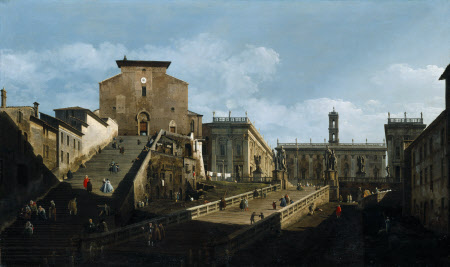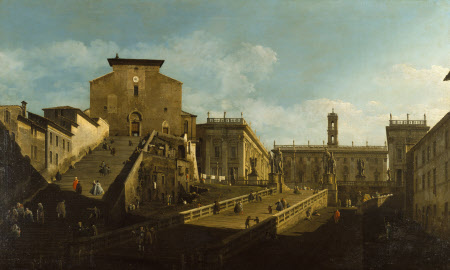Piazza del Campidoglio with Santa Maria d'Aracoeli, Rome
Bernardo Bellotto (Venice 1722 – Warsaw 1780)
Category
Art / Oil paintings
Date
circa 1742 - 1743
Materials
Oil on canvas
Measurements
864 x 1486 mm (34 x 58 1/2 in)
Place of origin
Venice
Order this imageCollection
Petworth House and Park, West Sussex
NT 486296
Caption
Bernado Bellotto was the nephew and pupil of Antonio Canaletto. Their ‘vedute’ were particularly popular with Grand Tourists, who wanted mementoes of their travels. Stylistically their paintings are very similar, to the extent that attributions have often been confused. This picture was formerly thought to be by Canaletto, but - amongst other features - the diagonal, raking brush strokes in the sky, the clouds like icing sugar, and the use of black paint to depict stonework, set it apart as a work by Bellotto. Here, the ascending roadway leads up between the statues of the twins, Castor and Pollux, whilst to the left, the steps lead up to the Piazza and the Palazzo del Senatore. Bellotto has used dramatic contrasts of light and shade to create visual impact. The casting of shadow along the bottom of the picture plane was also a characteristic feature of his work.
Summary
Oil painting on canvas, Piazza del Campidoglio with Santa Maria d'Aracoeli, Rome by Bernardo Bellotto (Venice 1722 – Warsaw 1780), circa 1742. Probably painted in Venice after a sketch that Bellotto, Canaletto's nephew, made on the spot in 1742. The painting has been executed displaying strong sun and shade. In the centre, the ascending roadway leads up between statues of Castor and Pollux, whilst at left the steps lead up to the Piazza and the Palazzo del Senatore. At right, the Via delle Tre Pile, where a coach is driving round the bend; on a lower level in deep shade a woman can be seen in the court of a house.
Provenance
The picture is apparently first recorded in Venice in 1743 in the Scuola di San Rocco; Earl of Thomond, Dover Street, London, 1774; at No. 4, Grosvenor Place in 1847 and at Petworth in 1856; thence by descent, until the death in 1952 of the 3rd Lord Leconfield, who had given Petworth to the National Trust in 1947, and whose nephew and heir, John Wyndham, 6th Lord Leconfield and 1st Lord Egremont (1920-1972) arranged for the acceptance of the major portion of the collections at Petworth in lieu of death duties (the first ever such arrangement) in 1956 by HM Treasury
Credit line
Petworth House, The Egremont Collection (acquired in lieu of tax by HM Treasury in 1956 and subsequently transferred to the National Trust)
Makers and roles
Bernardo Bellotto (Venice 1722 – Warsaw 1780), artist previously catalogued as attributed to Antonio Canaletto (Venice 1697 - Venice 1768) , artist
Exhibition history
Souvenirs of the Grand Tour, Wildenstein & Co., London, 1982, no.5
References
Kozakiewicz 1972 Stefan Kozakiewicz, Bernardo Bellotto, London 1972, vol. I, pp. 35- 38, vol. II, pp. 55 - 56 Kowalczyk 1995, Anna Bozena Kowalczyk, Bernardo Bellotto, Splendori del Settecento Veneziano, Milan 1995, p. 298 - 305 Kowalczyk & Fumei, 2001 Anna Bozena Kowalczyk and Corta Fumei Bernard Bellotto 1722 - 1780, MIlan, Electa, 2001, p, 100 - 101 Remastered - Bosch to Bellotto: An Exhibition of Petworth's European Old Masters (exh cat) (Andrew Loukes) Petworth House, West Sussex, 9 January - 6 March 2016, cat, 44, p. 21

